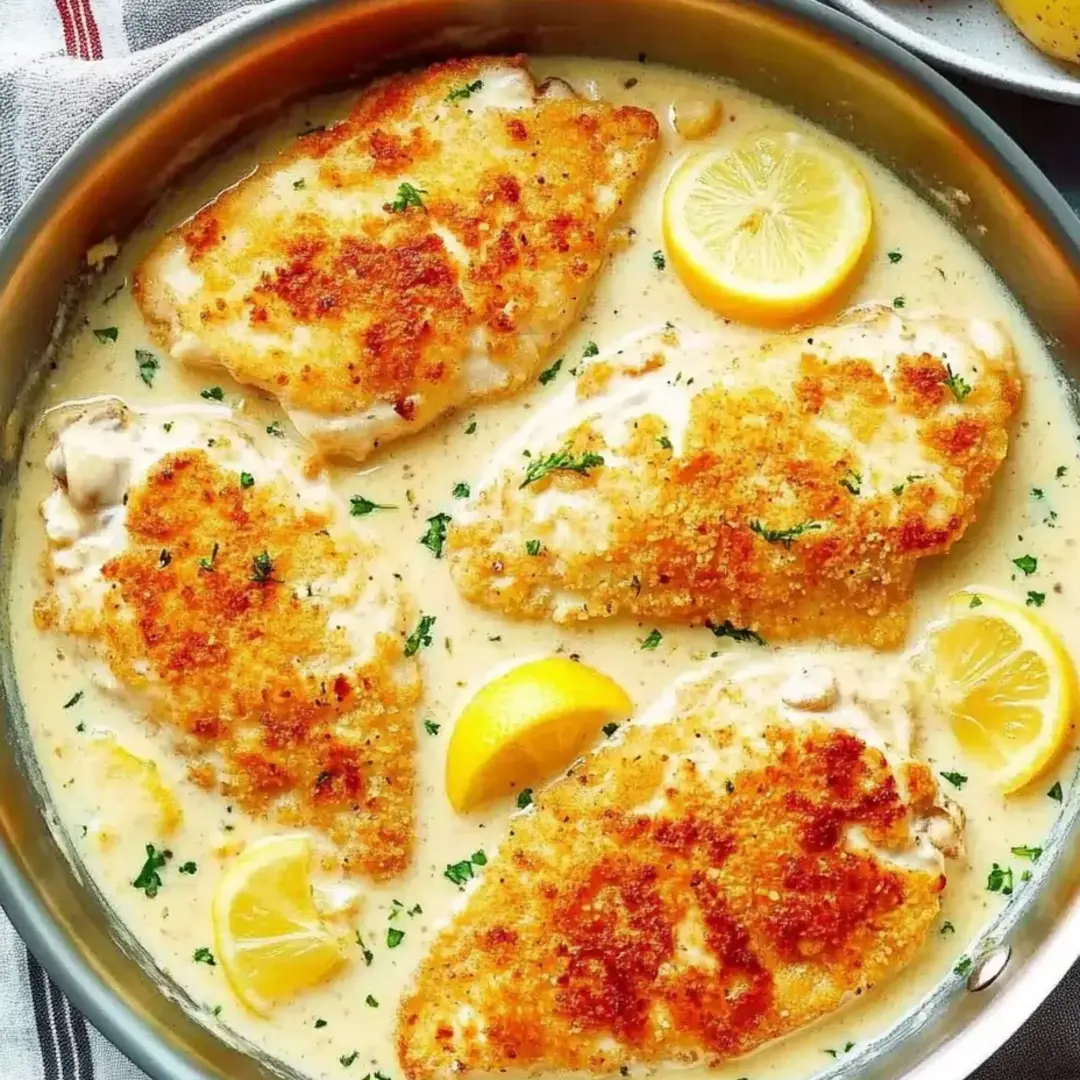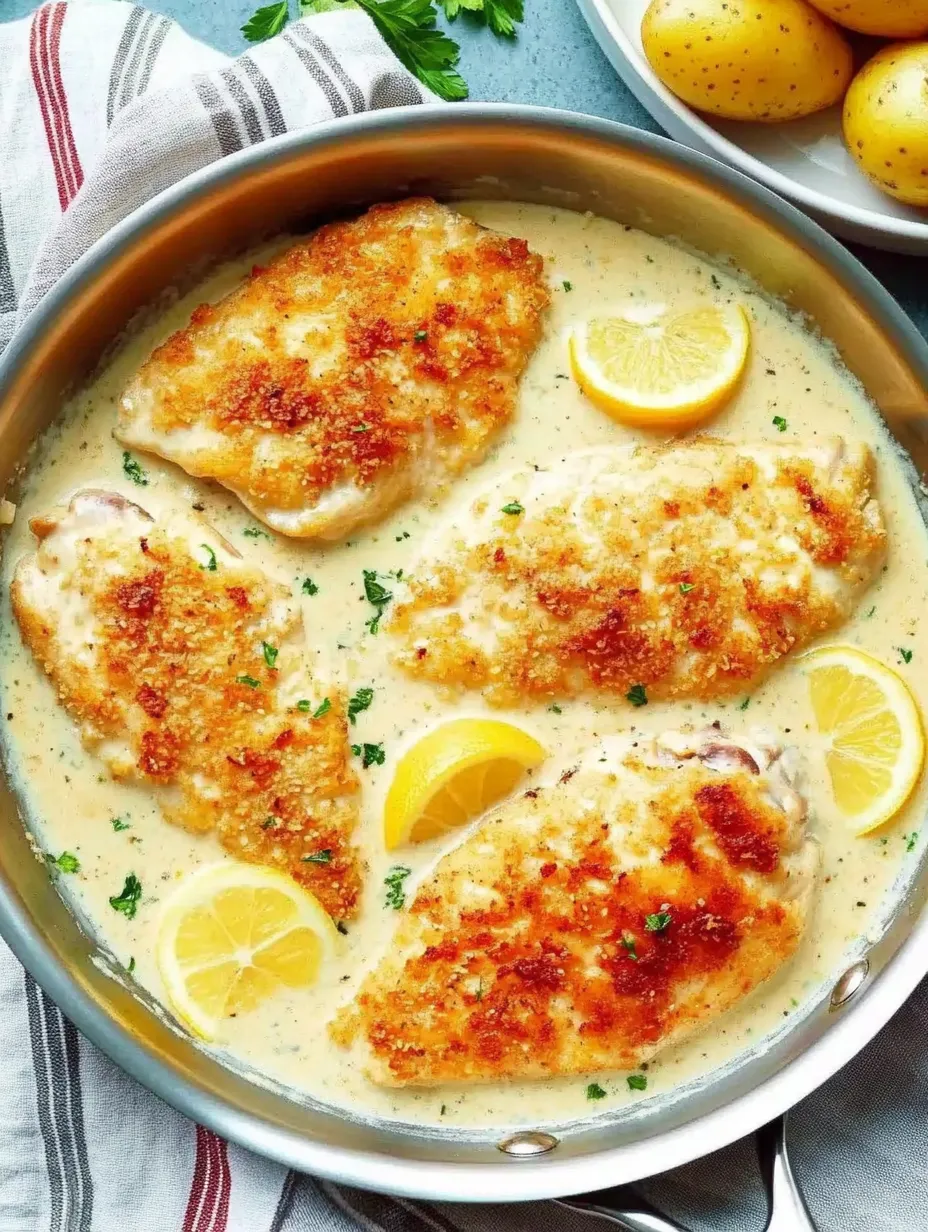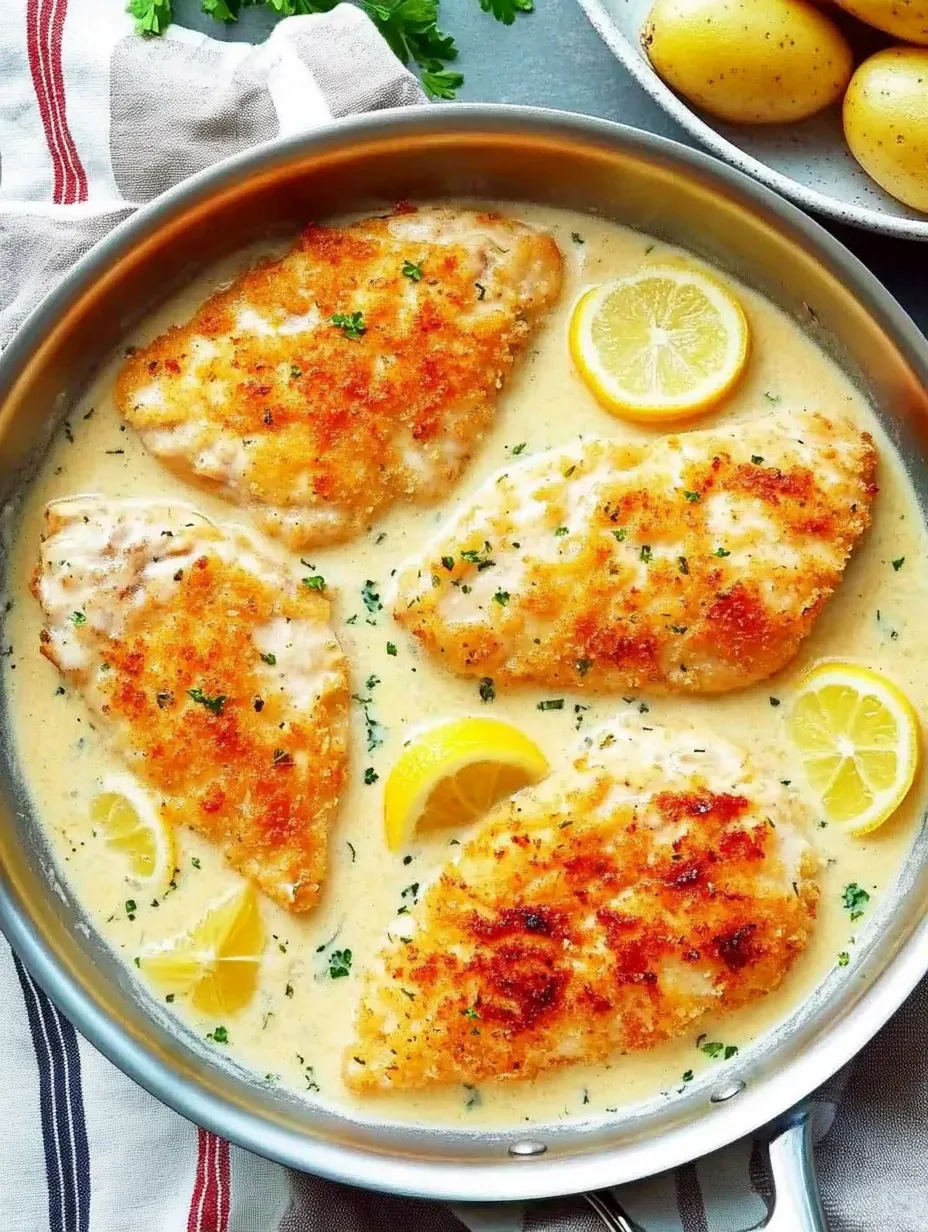 Pin it
Pin it
Creamy Lemon Garlic Chicken transforms simple chicken breasts into a restaurant-worthy meal with minimal effort. The combination of zesty lemon and aromatic garlic creates a velvety sauce that clings beautifully to each piece of tender chicken. With its perfect balance of brightness from the citrus and richness from the cream, this dish manages to be simultaneously comforting and refreshing. The quick cooking time and impressive results make this recipe the ideal solution for those evenings when you want something special without spending hours in the kitchen.
I made this last week when unexpected dinner guests showed up, and everyone was scraping their plates clean! Even my picky nephew, who normally pushes anything with "sauce" to the side of his plate, asked for seconds. The combination of the bright lemon with the creamy sauce seems to win over even the most reluctant eaters.
Ingredients
- Chicken breasts: The foundation of this dish, they become tender and flavorful when sliced thin and quickly seared. Look for plump, evenly-sized breasts for the best results. If yours are particularly large, you may want to pound them slightly for more even cooking.
- All-purpose flour: Creates a light coating that helps the chicken brown beautifully and thickens the sauce slightly. This thin dusting is essential for developing those flavorful browned bits that become the foundation of the sauce.
- Olive oil: Used for sautéing, it adds a subtle fruity note that complements the lemon. A good quality extra virgin olive oil makes a noticeable difference in the final flavor.
- Butter: Adds richness and helps create a silky texture in the sauce. Using butter at two different stages - both for cooking and finishing - creates layers of buttery flavor.
- Garlic: Provides aromatic depth that balances the brightness of the lemon. Fresh garlic cloves, finely minced, deliver the most vibrant flavor. Don't be shy with the amount - 3-4 cloves is perfect.
- Shallot: Offers a delicate onion flavor that's milder and sweeter than regular onions. Its subtle presence enhances the sauce without overwhelming the other flavors.
- Lemon: The star ingredient that cuts through the richness with bright acidity. Using both the zest and juice maximizes flavor - the oils in the zest contain different compounds than the juice, creating a more complex lemon profile.
- Chicken stock: Forms the savory base of the sauce and helps deglaze all those flavorful browned bits from the pan. Homemade stock is wonderful, but a good quality store-bought version works beautifully too.
- Heavy cream: Creates the luxurious texture that makes this sauce so irresistible. Its high fat content allows the sauce to reduce without curdling, even with the acidic lemon.
- Salt and pepper: Essential seasonings that enhance all the other flavors. Kosher salt and freshly ground black pepper make a noticeable difference in the final dish.
 Pin it
Pin it
Step-by-Step Instructions
- Step 1:
- Prepare the chicken properly - Begin by placing your chicken breasts on a cutting board and carefully slicing each one horizontally (parallel to the cutting board) to create two thinner cutlets from each breast. This technique is called butterflying and is crucial for quick, even cooking and maximum tenderness. Season both sides of each piece generously with salt and freshly ground black pepper, allowing the seasonings to adhere to the surface. Next, place about half a cup of all-purpose flour on a plate and lightly dredge each chicken piece, shaking off any excess. This thin coating will help achieve a beautiful golden crust and slightly thicken the sauce later.
- Step 2:
- Master the perfect sear - Heat a large skillet (preferably stainless steel or cast iron) over medium-high heat. Add two tablespoons of olive oil and one tablespoon of butter, swirling to coat the pan as the butter melts. Once the butter stops foaming and the mixture is hot, carefully place the chicken pieces in the pan without overcrowding - work in batches if necessary. Let them cook undisturbed for about 3-4 minutes until they develop a rich golden-brown crust. Using tongs, flip each piece and cook for another 2-3 minutes until the second side is equally golden and the chicken is just cooked through. Transfer the chicken to a clean plate and cover loosely with foil to keep warm while making the sauce.
- Step 3:
- Build flavor with aromatics - In the same pan with all those flavorful browned bits, add another tablespoon of olive oil. Reduce the heat to medium and add one finely minced shallot (about 2 tablespoons) and 3-4 minced garlic cloves. Sauté gently for about 1-2 minutes until softened and fragrant, being careful not to let the garlic brown, which would make it bitter. Use a wooden spoon to scrape up any browned bits from the bottom of the pan as you stir - these contain concentrated flavor that will enrich your sauce.
- Step 4:
- Create the citrus foundation - Add the zest of one lemon and the juice of half that lemon to the pan (about 1½ tablespoons of juice), stirring to combine with the aromatics. The oils in the zest will release their aroma in the heat, and the juice will sizzle as it hits the hot pan, reducing slightly and intensifying in flavor. This brief cooking of the lemon juice takes away some of its sharp edge while maintaining its bright character.
- Step 5:
- Develop the sauce body - Pour in ¾ cup of chicken stock, stirring constantly and scraping the bottom of the pan to incorporate any remaining browned bits. Bring this mixture to a simmer and let it reduce by about one-third, approximately 2-3 minutes. This concentration intensifies the flavors and prepares the base for the cream. The liquid should be bubbling gently around the edges during this process.
- Step 6:
- Create the silky texture - Lower the heat to medium-low and slowly pour in ½ cup of heavy cream while stirring constantly. This gradual addition helps prevent the cream from separating when it meets the acidic lemon juice. Let the sauce simmer gently for another 2-3 minutes until it thickens slightly and coats the back of a spoon. The sauce will still be pourable but with a rich, silky consistency. Taste and adjust the seasoning with additional salt and pepper as needed.
- Step 7:
- Reunite the chicken with the sauce - Carefully return the chicken pieces to the pan, including any juices that have collected on the plate. Spoon some of the sauce over each piece and let everything simmer together for about 1-2 minutes, allowing the chicken to warm through and absorb some of the sauce flavors. The flour from the chicken will help thicken the sauce a bit more as well.
- Step 8:
- Finish with butter enrichment - For the final touch of luxury, turn off the heat and add the remaining tablespoon of butter to the pan. Gently swirl or stir until the butter melts completely into the sauce, creating an extra layer of richness and giving the sauce a beautiful glossy finish. This technique, called "mounting with butter," is a restaurant secret for creating incredible sauces. Garnish the dish with freshly chopped parsley and thin lemon slices for both flavor and visual appeal before serving.
The Magic of Pan Sauce
What makes this dish truly special is the technique of creating a pan sauce—using the same skillet where you cooked the chicken to build layers of flavor. When the chicken is dredged in flour and cooked, it leaves behind what chefs call "fond"—those golden-brown bits stuck to the bottom of the pan. This is pure flavor gold! When you deglaze the pan with chicken stock, those bits dissolve and become the foundation of your sauce. This technique transforms simple ingredients into something extraordinary with minimal effort, and it's a cooking method worth mastering for countless other dishes.
Achieving the Perfect Consistency
The secret to a restaurant-quality cream sauce is getting the consistency just right. Too thin, and it won't cling to the chicken; too thick, and it becomes heavy and gluey. The gradual reduction method used in this recipe allows you to control the thickness naturally without relying on additional thickeners. Watch for visual cues: the perfect sauce should coat the back of a spoon and when you run your finger through it, the line should hold for a moment before slowly filling in. If your sauce reduces too much, simply add a splash more stock to thin it. If it's too thin, let it simmer a bit longer.
 Pin it
Pin it
Lemon: More Than Just Juice
This recipe showcases lemon in its full glory by using both the zest and juice. The zest contains the essential oils where much of the aromatic compounds reside, providing that distinctive citrus fragrance. The juice contributes the bright acidity that cuts through the richness of the cream. Together, they create a more complex, rounded lemon flavor than either would alone. When zesting, take care to get only the yellow outer layer—the white pith underneath is bitter and can throw off your sauce's flavor balance.
The Perfect Pairings
While this chicken is undoubtedly the star of the show, what you serve alongside it can elevate the entire meal. Starchy sides like creamy mashed potatoes, fluffy rice, or al dente pasta are ideal for soaking up the delicious sauce. For vegetables, consider simple preparations that won't compete with the chicken's flavor profile: steamed asparagus, sautéed spinach, or roasted green beans complement the dish beautifully. A side of crusty bread is also wonderful for ensuring not a drop of sauce goes to waste.
I've made this dish countless times, and I've found that using room temperature cream makes a huge difference in preventing separation when it hits the hot pan with lemon juice. I always take my cream out of the refrigerator at least 15 minutes before cooking. My grandmother taught me this trick, and it works like a charm every time!
This Creamy Lemon Garlic Chicken has become my go-to recipe when I want to impress without stress. There's something magical about how a handful of simple ingredients transform into such an elegant meal. The way the sauce gently bubbles as it reduces, filling the kitchen with the aroma of garlic and lemon, signals that something special is about to happen. I love watching people's eyes light up when they take that first bite – the moment when the tangy lemon cuts through the richness of the cream, balanced perfectly by the savory notes from the chicken and stock. It's simple food elevated to something memorable, proving that the most satisfying meals don't require complicated techniques or exotic ingredients – just a little attention to detail and an understanding of how flavors work together.
Frequently Asked Questions
- → Can I use chicken thighs instead of breasts?
- Yes, boneless chicken thighs work well in this recipe and stay even juicier. You may need to adjust cooking time slightly as thighs can take a bit longer to cook.
- → What can I substitute for heavy cream?
- You can use half-and-half for a lighter option, or as noted in the recipe, mix milk with cornstarch (1½ teaspoons cornstarch to ½ cup milk) to achieve a similar creamy consistency.
- → Can I make this dairy-free?
- You can substitute the butter with olive oil and the heavy cream with full-fat coconut milk or a dairy-free cream alternative, though the flavor profile will change slightly.
- → What sides go best with this chicken?
- This chicken pairs wonderfully with mashed potatoes, rice, pasta, or roasted vegetables. The creamy sauce is perfect for spooning over any starch.
- → Can I make this ahead of time?
- This dish is best served fresh, but you can reheat leftovers gently on the stovetop with a splash of chicken broth to revive the sauce if it thickens too much when chilled.
